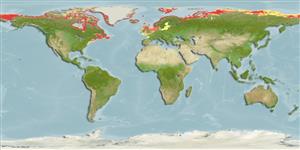Classification / Names
Common names | Synonyms | Catalog of Fishes (gen., sp.) | ITIS | CoL | WoRMS | Cloffa
Actinopterygii (ray-finned fishes) >
Salmoniformes (Salmons) >
Salmonidae (Salmonids) > Salmoninae
Etymology: Salvelinus: Old name for char; it is the same root of german "saibling" = little salmon (Ref. 45335).
Issue
The species Salvelinus aureolus Bean, 1887 is considered as valid in Eschmeyer (CofF ver. May 2011: Ref. 86870) following Fuller et al. (1999: Ref. 87253). Treated as synonym of Salvelinus alpinus oquassa by Qadi (1974: Ref. 87252); and probably a synonym of Salvelinus alpinus
Environment / Climate / Range
Ecology
Marine; freshwater; brackish; benthopelagic; anadromous (Ref. 51243); depth range 0 - 70 m (Ref. 30578), usually 0 - 1 m (Ref. 101587). Temperate; 4°C - 16°C (Ref. 2059), preferred ? (Ref. 107945); 85°N - 42°N, 180°W - 180°E
Europe: northern Atlantic southward to southern Norway, also Iceland and southern Greenland. Isolated populations in Northern UK, Scandinavia, Finland and the Alps. North America: Landlocked populations in Quebec, Canada and in Maine and New Hampshire in USA (Ref. 7251).
Length at first maturity / Size / Weight / Age
Maturity: Lm 60.0 range ? - ? cm
Max length : 107 cm TL male/unsexed; (Ref. 40637); common length : 40.0 cm TL male/unsexed; (Ref. 4779); max. published weight: 15.0 kg (Ref. 4779); max. reported age: 40 years (Ref. 46974)
Dorsal
spines
(total): 4 - 5;
Dorsal
soft rays
(total): 8-16;
Anal
spines: 3-4;
Anal
soft rays: 7 - 15;
Vertebrae: 62 - 68. Distinguished by the presence of 23 to 32 gill rakers, 37 to 75 pyloric caeca and, on the sides and back, pink to red spots, the largest of which are usually larger than the pupil of the eye (Ref. 27547). Lateral line curves slightly downward from the head (Ref. 27547). Pelvic fins with axillary process; caudal emarginate (Ref. 27547). Color highly variable, depending on location, time of year and degree of sexual development. In general, back is dark, usually rather brown but sometimes with a green cast; the sides are lighter, belly pale; sides and back are liberally sprinkled with pink to red spots, the largest spots along the lateral line usually larger than the pupil of the eye; forward edges of pectoral, pelvic and anal fins, and sometimes the caudal, with a narrow white margin; fins pale in young, dorsal and caudal dark in adults (Ref. 27547). Spawning adults, especially males, are brilliant orange-red to bright red on the ventral side and on the pectoral, pelvic and anal fins. Young have about 11 dark parr marks on each side (Ref. 27547). Caudal fin with 19 rays (Ref. 2196).
Anadromous forms spend a considerable time of their lives at sea; non-migratory populations remain in lakes and rivers (Ref. 4779). Found in rivers, estuaries and lakes with cold, clear water. Occurs mainly in lakes. At the sea, lives along coasts (Ref. 59043). Inhabits deep runs and pools of medium to large rivers, and lakes (Ref. 5723). Nerito-pelagic (Ref. 58426). Freshwater populations feed on planktonic crustaceans, amphipods, mollusks, insects and fishes (Ref. 4479). Anadromous individuals feed little in freshwater and never feed during migrations. Spawning usually takes place on pebble to stone bottom in lakes. Riverine stocks spawn in rivers with slow current (02.-0.8 m/s), but there are some riverine anadromous stocks (in Norway) which spawn in fast-flowing waters of riffles (Ref. 59043). Extremely sensitive to water pollution (cold water and oxygen oriented) (Ref. 2163). Marketed fresh, smoked, canned (Ref. 27547), and frozen. Eaten sautéed, broiled, fried, microwaved and baked (Ref. 9988). Parasitized by tapeworm (Ref. 37032).
Males are generally territorial but when females start showing spawning behavior, males pair up with females and lose interest in their territories. Spawning takes place at almost any time of the day. A female invades a males territory and finds a suitable spot for a redd. Once a spot has been selected, she starts digging. While the female is digging, the male courts her by circling around her and then gliding along her side and quivering. When the redd is completed, the pair release egg and sperm. The pair then swim forward out of the nest, often still ejecting sex products. This may be repeated up to 5 times before the female begins to cover the eggs. The female then digs at the edge of the pit, covering the eggs and beginning the next redd (Ref. 27547). Males often mate with more than one female, taking the second mate after the first has exhausted the eggs. Sometimes, a female will mate successively with two or more males (Ref. 28968, 28969). Several days are usually required for females to deposit all their eggs (Ref. 27547).
Svetovidov, A.N., 1984. Salmonidae. p. 373-385. In P.J.P. Whitehead, M.-L. Bauchot, J.-C. Hureau, J. Nielsen and E. Tortonese (eds.) Fishes of the north-eastern Atlantic and the Mediterranean. UNESCO, Paris. vol. 1. (Ref. 4779)
IUCN Red List Status (Ref. 115185)
CITES (Ref. 94142)
Not Evaluated
Threat to humans
Harmless
Human uses
Fisheries: minor commercial; aquaculture: commercial; gamefish: yes
Tools
Special reports
Download XML
Internet sources
